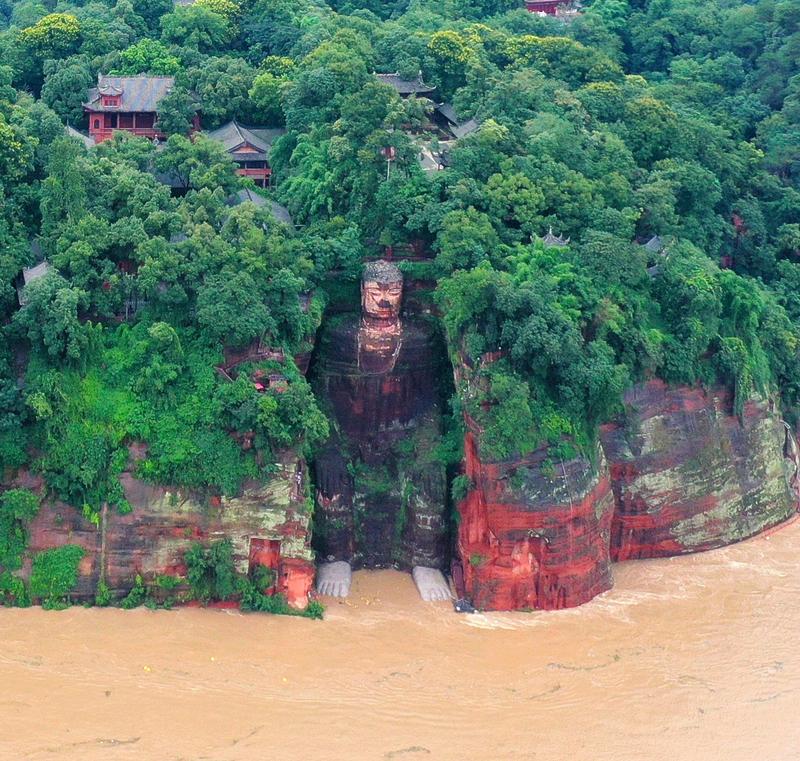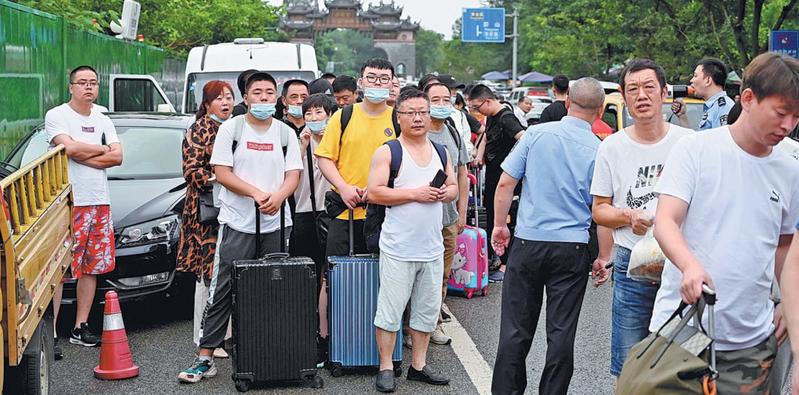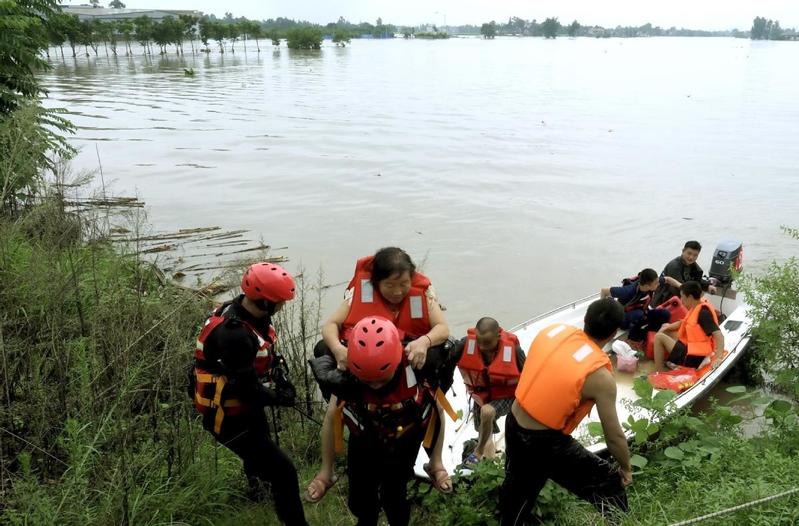 The toes of the Leshan Giant Buddha, a UNESCO World Heritage Site in Leshan city, Sichuan province, are submerged in floodwater on Aug 18, 2020. (LI XINFENG / FOR CHINADAILY.COM.CN)
The toes of the Leshan Giant Buddha, a UNESCO World Heritage Site in Leshan city, Sichuan province, are submerged in floodwater on Aug 18, 2020. (LI XINFENG / FOR CHINADAILY.COM.CN)
Sichuan province raised its flood-control response to Level I on Tuesday morning, the highest of its four-tier emergency response system. This is the first time the province has triggered a Level I response for floods.
The Ya'an section of the Qingyi River was hit by a major flood rarely seen in a hundred years, while water levels in the entire Qingyi River basin, as well as the lower reaches of Dadu River and Minjiang River, are expected to exceed warning levels.
Sichuan raised its flood-control response to Level I on Tuesday morning, the highest of its four-tier emergency response system. This is the first time the province has triggered a Level I response for floods
Floods also affected the Leshan Giant Buddha, a UNESCO world heritage site situated outside the city of Leshan.
As of around 10 am Tuesday, floodwater surged past the toes of the Buddha statue. According to the management committee of the attraction, it is the first time since 1949 that floodwater reached the toes of the 71-meter-high statue.
More than 130 people, including policemen and staff at the attraction, carried sandbags to the feet of the Giant Buddha against the rain and managed to build an embankment to help protect the statue on Monday night as a new round of rainstorms hit the city.
There is an old saying in Leshan - the city will be flooded entirely when the Giant Buddha's feet are flooded.
Leshan has activated its highest-level flood control response.
 Huanglongxi, a town with a history of more than 2,000 years in Chengdu, Sichuan province, is flooded on Aug 17, 2020 by two rivers that swelled as a result of recent downpours. (LIU ZHONGJUN / CHINA NEWS SERVICE)
Huanglongxi, a town with a history of more than 2,000 years in Chengdu, Sichuan province, is flooded on Aug 17, 2020 by two rivers that swelled as a result of recent downpours. (LIU ZHONGJUN / CHINA NEWS SERVICE)
A total of 119,780 people had been relocated by Monday in Neijiang following rain-induced floods.
In Zizhong, a county under the administration of Neijiang, the rising water levels in rivers in many towns exceeded the level in 2018 when an extraordinary flood peak passed, said Zhou Sheng, Party chief of Guide town.
In the wee hours of Monday, the Tuojiang River, a tributary of the Yangtze River, overflowed the dike in the town.
"More than half of the area of the town has been inundated," Zhou said. "The road leading to the town has been flooded and the town itself has become an isolated island. A total of 3,116 people from 986 families have been relocated, which accounts for more than half of the town's permanent population."
ALSO READ: Casualties from floods drop by 55%
 People wait in line to be relocated from Huanglongxi, a town in Chengdu, Sichuan province, on Aug 17, 2020. More than 7,000 people in the town have been evacuated to safer areas, officials said. (LIU ZHONGJUN / CHINA NEWS SERVICE)
People wait in line to be relocated from Huanglongxi, a town in Chengdu, Sichuan province, on Aug 17, 2020. More than 7,000 people in the town have been evacuated to safer areas, officials said. (LIU ZHONGJUN / CHINA NEWS SERVICE)
At 11 am on Monday, Neijiang issued an orange alert for floods, and 14 leading officials headed by the city's Party secretary Ma Bo went to different disaster-stricken areas to direct rescue and relief operations.
A total of 119,780 people had been relocated by Monday in Neijiang following rain-induced floods
China has a four-tier, color-coded disaster warning system, with red representing the most severe, followed by orange, yellow and blue.
China's national observatory on Monday continued to issue an orange alert for rainstorms in several provinces and regions.
READ MORE: Water projects stand test of strongest floods in 20 years
From 2 pm on Monday to 2 pm on Tuesday, torrential rain and rainstorms were expected to lash parts of the Sichuan Basin. Certain western areas of the basin would experience downpours, the National Meteorological Center said.
It advised local authorities to stay vigilant for possible flooding, landslides and mudslides and suggested halting outdoor activities in disaster-prone areas.
 Rescuers transfer local people in Jintang county after heavy rainfall brought floods in Chengdu, Sichuan province, on Aug 17, 2020. (YIN GANG / FOR CHINA DAILY)
Rescuers transfer local people in Jintang county after heavy rainfall brought floods in Chengdu, Sichuan province, on Aug 17, 2020. (YIN GANG / FOR CHINA DAILY)
Sichuan's flood control and drought relief headquarters on Monday upgraded its flood-control response to Level II, the second highest in the four-tier emergency response system for floods, from Level III initiated on Saturday.
The upgrading came in the aftermath of excessive rainfall that swelled rivers. The water level of 32 rivers in the province exceeded their warning lines on midday on Monday.
READ MORE: Strong storms expected to soak north China
Heavy rain also wrought havoc in the Sichuan capital of Chengdu, resulting in the evacuation of more than 1,000 people on the weekend from the Tianfu New Area in the city as well as five districts, two cities and one county under the city's administration.
Xinhua contributed to this story.
huangzhiling@chinadaily.com.cn


